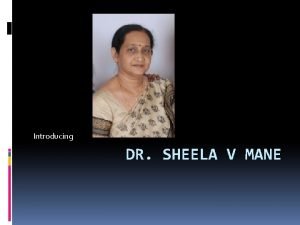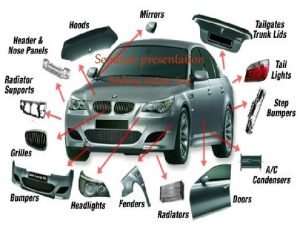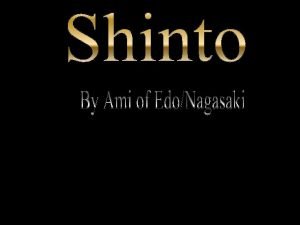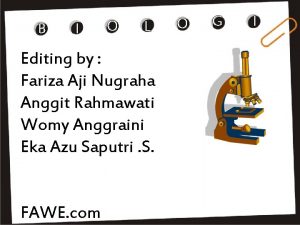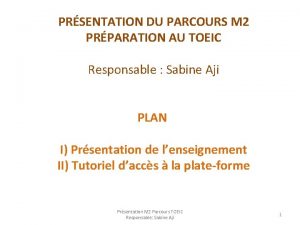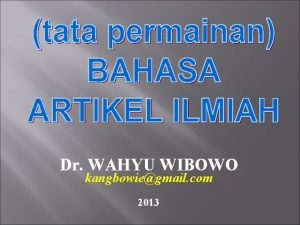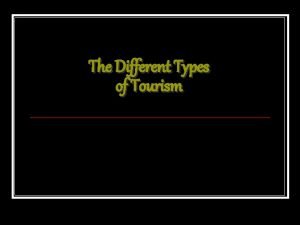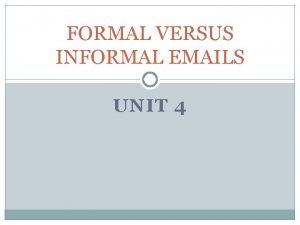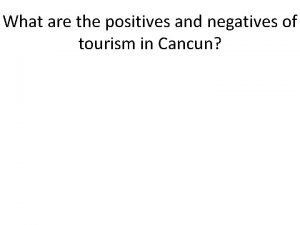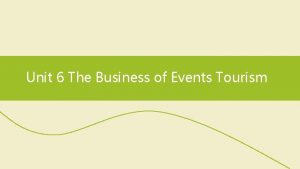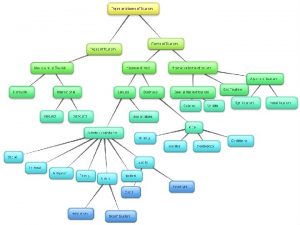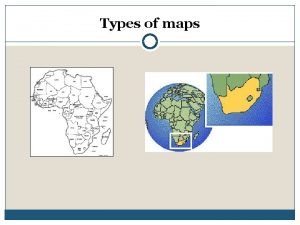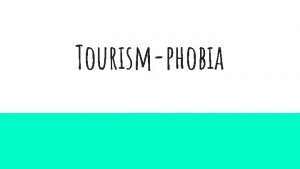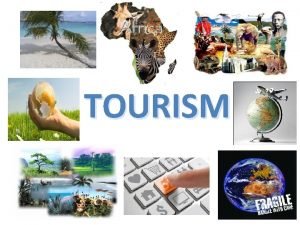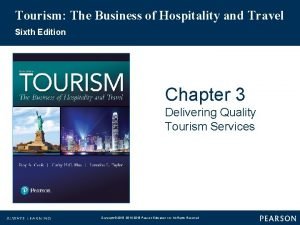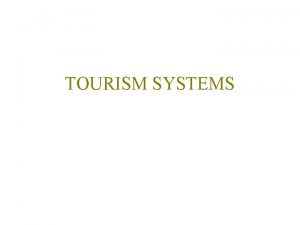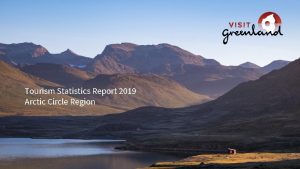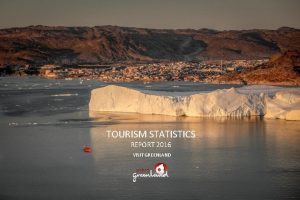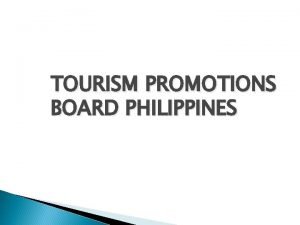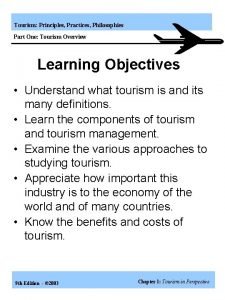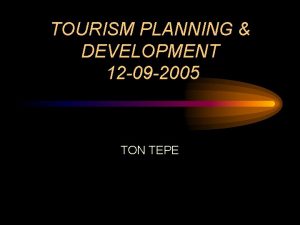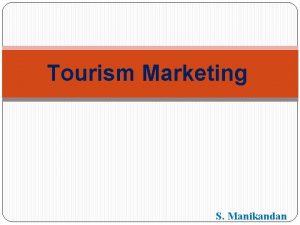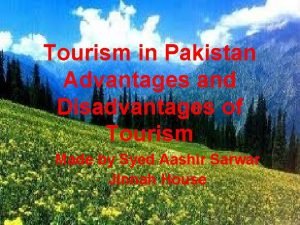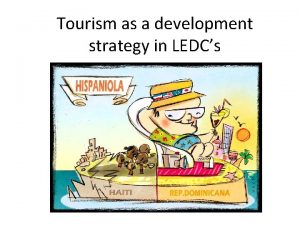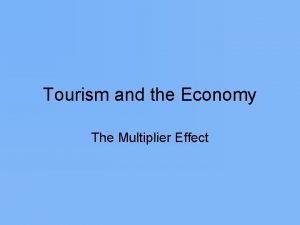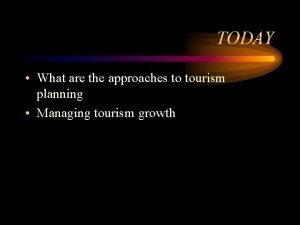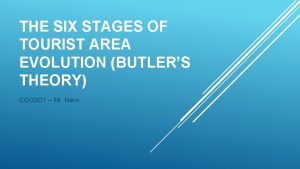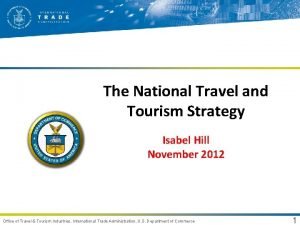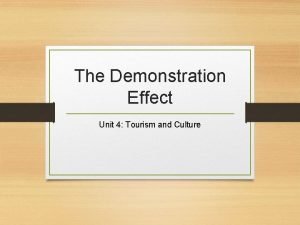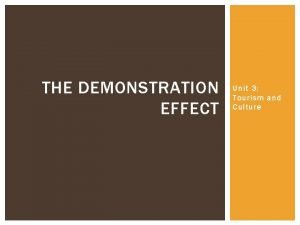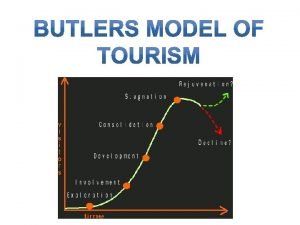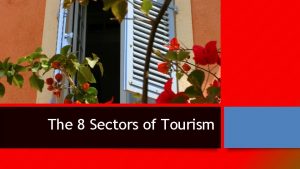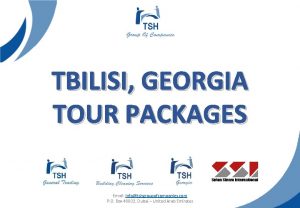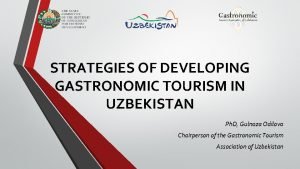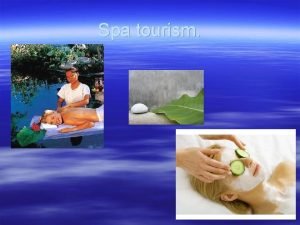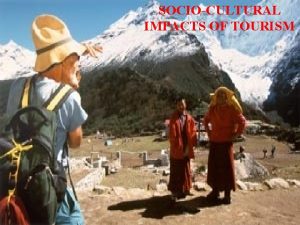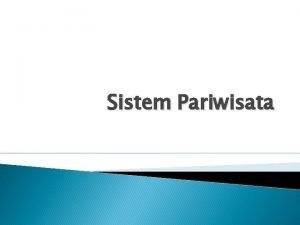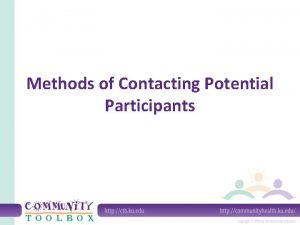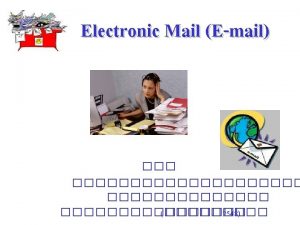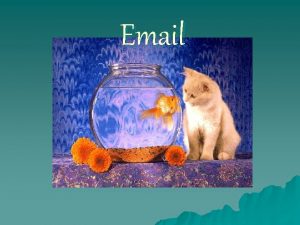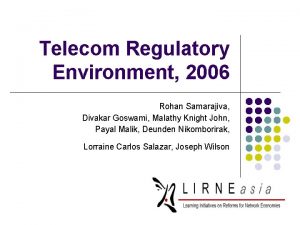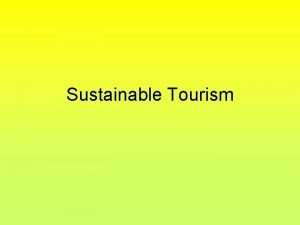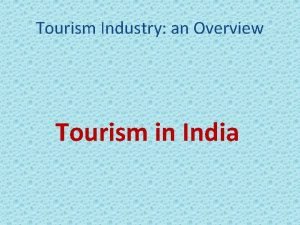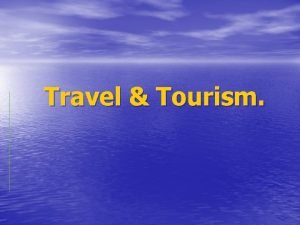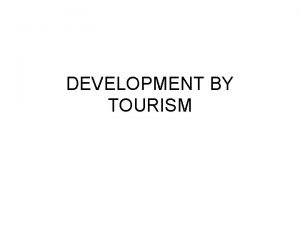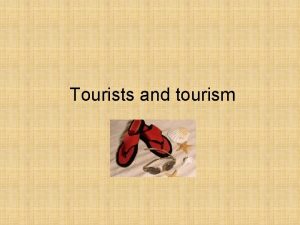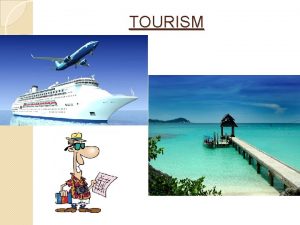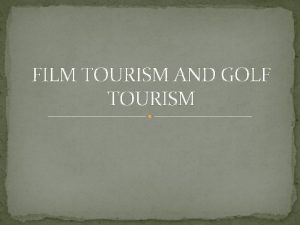TOURISM SYSTEMS Contacting me AJI DIVAKAR Email tourskeralayahoo
















































- Slides: 48

TOURISM SYSTEMS

Contacting me AJI DIVAKAR Email: tourskerala@yahoo. com Write your Name and Module in the subject line. Sub: John Smith, Tourism System.

Module Delivery • 11 Weeks, 10 Chapters • Lecture 3 Hours • Session 1 : Lecture – Break • Session 2: Tutorial

Exam • • • 100 Marks 70% towards final Marks 3 Hours Section A : Multiple Choice 20 marks Section B : 3 Essay Questions Choose Any 2 (20 marks each) • Section C : 3 Essay Questions Choose any 2 (20 marks each)

Assignment • • • 3 parts : A, B and C 30 Marks Group/Individual Assignment 4 member per group (not more than 4) Individual for part time students

Topic: – Destination study – Select any destination from this list. – Places of a Lifetime – Amsterdam Athens – Barcelona Berlin – Boston Budapest – Cape Town Chicago – Dallas Dubai – Florence Istanbul Atlanta Buenos Aires Dublin Jerusalem

Topic: – Destination study – Select any destination from this list. – Places of a Lifetime – Las Vegas London – Madrid Mexico City – Montreal Moscow – Paris Philadelphia Los Angeles Miami New York Prague

Topic: – Destination study – Select any destination from this list. – Places of a Lifetime – Rio de Janeiro Rome – San Diego San Francisco – St. Petersburg Stockholm – Toronto Vancouver – Venice Vienna Seattle Washington, D. C.

Assignment 1 • Tourism of this Destination • Scope of the tourism industry of your destination – Arrival numbers, Tourism receipts, Key segments (geographic) etc. • Tourism Promoters in the area – NTO, Local agencies, distributors, portals/websites etc • Service Providers – Hotels (Number of hotels (how many in each category), number of rooms, – F&B sector, Cuisine influence (any). – Airlines ( the main airlines ) • Attractions in this destination. – Different types of attractions, natural, man made (any Theme Parks) any major events (like F 1), the numbers from those events

Assignment 1 • Presentation and Report – Use Power Point Slides – Submit Report (1000 Words + 20 Slides maximum) – Use Referencing. – Dates: • Presentation: 11 Feb 2008 • Report Submission: 11 Feb 2008

Chapter 1 Introduction to Tourism Model

Aim • What will you Learn today? – Tourism Definitions – Reasons for Travel – Types of Travelers – Features of Tourism Products. – Integrated Tourism Model

Hospitality/Tourism Industry OH –

TOURISM AND TRAVELLER Definitions of Tourism • “…the aggregate of all businesses that directly provide goods or services to facilitate business, pleasure, and leisure activities away from the home environment” Smith, S. L. J. (1990) Tourism Analysis, Longman, Harlow, Essex

“…the temporary movement of people to destinations outside their normal places of work and residence, the activities undertaken during their stay in those destinations, and the facilities created to cater to their needs”. Cook, R. A. , Yale, L. J. & Marqua, J. J. , 2002, Tourism - The Business of Travel, 2 nd edition, Prentice Hall, NJ.

UN Definitions • UNWTO: Activities of persons traveling to and staying in places outside their usual environment for more than one night but not for more than one year for leisure, business and other purposes. • Another common definition simply counts everyone as a tourist who travels at least 50 miles from home and stays away overnight.

THE MOTIVATION TO TRAVEL • People travel for various reasons…. • • • Business Pleasure Visiting Family To Learn To Challenge Themselves • And many more……

Tutorial Activity • Investigate 3 more reasons why people travel. – Example: Medical Tourism. – People from UK traveling to Thailand to do minor medical procedures like dental surgery.

How to Classify Tourist?

By Product Mass Tourism Alternative Tourism Package tour Ecotourism

By Nature of Activity Active Tourism Passive Tourism Adventure Tourism Golf Tourism Eco Tourism Cruise Holidays Sight Seeing Trips

By Purpose Business Pleasure Meetings Incentives Conventions etc Family Holidays Olympics

By Location Preferences Coastal Hawaii Rural Urban Mountain Lakes/Ri ver Scottish London Nepal Nile, Highland Egypt

Motivation Theories • Maslow’s Motivation Theory • Mc. Intosh, Goeldner and Ritchie (1995) • Stanley Plog’s Motivation Theory

Mc. Intosh, Goeldner and Ritchie (1995) • Physical Motivators: – body and mind, health purpose, sport and pleasure. • Cultural Motivators: – Know more about other cultures, to find out about the natives of a country, their life style, music, art, folklore, dance etc. • Interpersonal Motivators: – to meet new people, visit friends or relatives, and to seek new and different experiences. • Status and Prestige Motivators: – personal development, ego enhancement and sensual indulgence). – for recognition and attention from others, in order to boost the personal ego.

Plog’s Theory

Psychocentric • Prefer Familiar Destinations. • Prefer Low Activity levels. • Prefer buying complete tour packages • Less risk taking

Allocentric • Prefer non touristy places. • Prefer high level of activities. • Enjoy interacting with locals • Enjoy taking risk.

MARKET SEGMENTATION Definition: “Market segmentation is a process of dividing the total market for a tourism organization or destination into groups of travellers that share common characteristics Morrison, AM 1996

How to Segment? • A market is all actual and potential buyers of a product or service • Geographic Segmentation • Demographic Segmentation • Psychographic Segmentation • Behavior Segmentation

Geographic Segmentation • Dividing the market into different geographic units – Nations – States – Regions – Counties – Cities – Neighborhoods © 2006 Pearson Education, Inc. Upper Saddle River, NJ 07458 Marketing for Hospitality and Tourism, 4 th edition Kotler, Bowen, and Makens

• Hong Kong Tourism Up 12. 6 Percent in May • Hong Kong said Monday that May visitor arrivals jumped 12. 6 percent from a year ago to 2. 2 million, with more than half of the tourists coming from mainland China. long-haul markets like Australia, New Zealand the South Pacific _ which increased by 18. 7 percent, or 59, 507 visitors. Strong • The city also reported double-digit growth in growth also came from Europe, Africa and the Middle East, which contributed a total 161, 019 visitors _ a 15. 7 percent increase over last year, the Tourism Board said. But mainland China continued to deliver the bulk of the tourists. In May, about 1. 2 million mainlanders arrived, making up 55 percent of the total arrivals.

Demographic Segmentation • Dividing the market into groups based on demographic variables – Age – Gender – Income – Occupation © 2006 Pearson Education, Inc. Upper Saddle River, NJ 07458 Marketing for Hospitality and Tourism, 4 th edition Kotler, Bowen, and Makens

Psychographic Segmentation • Dividing buyers into different groups based on social class, lifestyle, and personality characteristics © 2006 Pearson Education, Inc. Upper Saddle River, NJ 07458 Marketing for Hospitality and Tourism, 4 th edition Kotler, Bowen, and Makens

Behavior Segmentation • Buyers are divided into groups based on their knowledge, attitude, and use or response to a product • The best starting point for building market segments • Types – Special occasion segmentation – Benefits sought – User status – Usage rate – Loyalty status – Buyer readiness stage © 2006 Pearson Education, Inc. Upper Saddle River, NJ 07458 Marketing for Hospitality and Tourism, 4 th edition Kotler, Bowen, and Makens

Segment your Destination • TUTORIAL: – What are the key segments for destination – Geographic – Other Segmentations

Class Exercise • IDENTIFY THE DEMOGRAPICS OF THE POTENTIAL VISITORS FOR THE FOLLOWING TOURIST ATTRACTIONS • DISNEY LAND, HONG KONG • BALI, INDONESIA • Mt. ANNAPURNA, NEPAL

Temporary Ownership Inseparability Intangibility Important Unique Attributes of the Tourism Products Perishability Heterogeneity

Intangibility Attributes of the Tourism Products CAN’T …. . TOUCH FEEL SMELL TRY …. BEFORE BUYING

Temporary Ownership Attributes of the Tourism Products GUEST CAN’T TAKE THE HOTEL ROOM WITH THEM.

In. Seperability Attributes of the Tourism Products YOU CAN’T SEPARATE SERVER AND THE SERVICE

Attributes of the Tourism Products VARIES FROM …PEOPLE TO PEOPLE PLACE TO PLACE Heterogeneity

Attributes of the Tourism Products Perishability USE IT OR LOSE IT

TOURISM V/S OTHER SERVICE SECTOR • More Supply led than other. • High Involvement and high risk product to consumers. • Constituted partly from peoples dreams and fantasies.

Tourism System • Leiper’s(1990) Tourism System Tourist Generating Area Traveler Transit Route Travelers Tourist Destination Region

Integrated Tourism Model • Several players at several stages involved in creating the product/service mix

A Tourism Model • Dynamic and interrelated nature of tourism • The traveling public (tourists) are the focal point (heart) of the model • Tourism promoters link the traveling public with the suppliers of services • Tourism service suppliers provide the services that tourists need when they travel • External forces affect all participants in tourism; tourists, promoters and suppliers • (Cooper et. al, 2006)

The Business of Tourism • STB Report and Key Numbers
 Sheela divakar family
Sheela divakar family External contracting brake image
External contracting brake image Aji-suki-taka-hi-kone
Aji-suki-taka-hi-kone Fariza aji nugraha
Fariza aji nugraha Sabine aji
Sabine aji Perbandingan kelereng dimas dan aji
Perbandingan kelereng dimas dan aji Dr wahyu aji wibowo
Dr wahyu aji wibowo Mass tourism vs alternative tourism
Mass tourism vs alternative tourism Email formal vs. informal
Email formal vs. informal Decision support systems and intelligent systems
Decision support systems and intelligent systems Dicapine
Dicapine Embedded systems vs cyber physical systems
Embedded systems vs cyber physical systems Elegant systems
Elegant systems Niche tourism examples
Niche tourism examples What are the positives of tourism
What are the positives of tourism Unit 6 tourism
Unit 6 tourism Different types of tourism
Different types of tourism Map of south africa
Map of south africa Types pf tourism
Types pf tourism Cook tourism
Cook tourism Tourism phobia definition
Tourism phobia definition Negative social impacts of tourism
Negative social impacts of tourism Tourism the business of hospitality and travel
Tourism the business of hospitality and travel Tourism system
Tourism system Arctic tourism statistics
Arctic tourism statistics Greenland tourism statistics
Greenland tourism statistics Tpb meaning in tourism
Tpb meaning in tourism Tourism principles practices philosophies
Tourism principles practices philosophies Tourism system
Tourism system Commercial tourism meaning
Commercial tourism meaning Tourism product development
Tourism product development Pakistan and tourism
Pakistan and tourism Importance of tourism essay
Importance of tourism essay Multiplier effect tourism
Multiplier effect tourism Multiplier effect tourism
Multiplier effect tourism Community oriented approach in tourism planning
Community oriented approach in tourism planning On this stage tourism growth slows
On this stage tourism growth slows Isabel hill commerce
Isabel hill commerce Example of demonstration effect in tourism
Example of demonstration effect in tourism Demonstration effect in economics
Demonstration effect in economics Butler's model
Butler's model 8 operating sectors of tourism industry
8 operating sectors of tourism industry Tbilisi tour package
Tbilisi tour package Gastronomic tourism in uzbekistan
Gastronomic tourism in uzbekistan Spa tourism
Spa tourism Negative social impacts of tourism
Negative social impacts of tourism Kazbegi tourism
Kazbegi tourism Elemen industri pariwisata adalah...
Elemen industri pariwisata adalah... Tertiary economic activities paris basin
Tertiary economic activities paris basin
